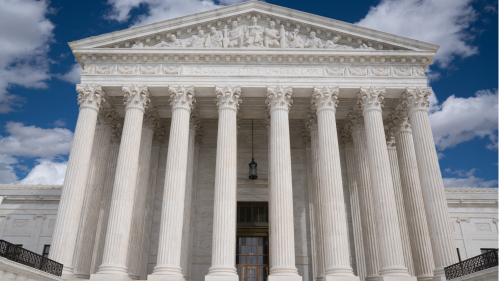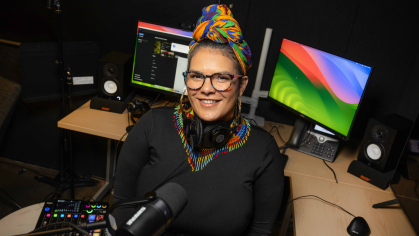What the Supreme Court Affirmative Action Ruling Means for College Admissions and Democracy Overall

The Supreme Court decision last week striking down affirmative action upended decades of precedent that allowed colleges and universities to use race and ethnicity as one of many factors in the admissions process.
Stacy Hawkins, professor at Rutgers Law School and a senior faculty fellow at the Institute for the Study of Global Racial Justice, talked to Rutgers Today about the potential consequences of the decision on college campuses and for democracy overall.
How will this ruling potentially change university admissions policies and practices?
It will not change some at all. Others will likely change significantly. According to the National Association for College Admission Counseling, as recently as 2019, more than half of all colleges surveyed said that race played no role in their admissions decisions. That means the decision will not change how these schools do admissions at all. The same survey reported that race is either a moderate or considerable factor in admissions for about a quarter of schools. Both Harvard and UNC, for example, described the role that race plays in their admissions process during the trial in these cases. For highly selective schools like Harvard and UNC, they will need to ensure that the mere fact of an applicant’s racial identity plays no part in the admissions decision. The Supreme Court was clear in affirming, however, that considering how an applicant’s race may have affected them, whether through essays or other information shared in the application, is still permissible.
Was there anything surprising about the decision?
It was surprising how broadly the majority opinion swept in striking down the admissions plans for both Harvard and UNC. Most people predicted that the court would point to the 25-year timeframe, cited in the 2003 case of Grutter, to find that it was time for race-conscious admissions plans to come to an end (even if five years early). However, the court went much further in striking down these plans. Not only did the court say the time for considering race in admissions had expired, it also said that the interest in diversity was incoherent and that the Harvard and UNC plans engaged in both racial stereotyping of Black and Hispanic students as well as negative treatment of Asian American students.
These last three findings were surprising because the court had previously reached the opposite conclusion on these issues in its prior affirmative action cases, and the trial courts below also reached the opposite conclusion about these specific admissions plans. Despite Chief Justice John Roberts’ insistence that these findings were consistent with the court’s prior holdings, they really do seem to establish a new legal standard.
Several states including California and Michigan already had bans in place against affirmative action. What can we learn from their experiences?
The first lesson is that there will likely be an immediate decline in the percentage of Black and Hispanic students attending those colleges and universities that have been relying on race in their admissions processes, and it will take some time (perhaps significant time) to recover those losses, if they are ever fully recovered. In fact, most of the rebound in California is due to significant demographic changes in the population, not to the ability to recover the losses suffered as a result of the ban on considering race in admissions. Given the different demographic trajectory of Michigan, they still have not fully recovered from the losses to their Black and Hispanic student population since their 2006 ban.
What it will take to recover these losses is lots of outreach to underrepresented high school students to build up pipelines of students who are ready and willing to attend these institutions in spite of what will likely be significant changes to the makeup of their student bodies.
What are the implications for racial equality on college campuses and beyond?
Ensuring student body diversity is a matter of racial equality. Justice Sandra Day O’Connor declared in the 2003 Grutter case that the legitimacy of our democracy depends on the ability of our educational institutions to train “qualified individuals of every race and ethnicity” to become the diverse future leaders our country needs.
Harvard and UNC, as well as other schools that filed amicus briefs in these cases, made very clear that they still need to use race in admissions to ensure that Black and Hispanic students are well represented at their schools. It is also true that schools like Harvard generate a disproportionate share of our nation’s leaders, as indicated by the fact that four of the court’s nine justices are alums of Harvard Law School. As a consequence of the Supreme Court’s decision, what we will see is not only a decline in the representation of “qualified individuals of every race and ethnicity” at these schools, we will also see the legitimacy of our democracy compromised by these schools’ inability to train the diverse set of future leaders our country so sorely needs.
Are there other ways for schools to achieve goals of a diverse student body?
The most effective way to achieve student body diversity is to directly select for the diversity that schools desire. If schools want students with different majors, from different geographic regions, of different socioeconomic backgrounds, or who engaged in a variety of different extracurricular activities in high school, they can directly select for all of those qualities without any limitations. However, if schools want students of different races and ethnicities, the Supreme Court has now declared that the only way schools can select for that kind of diversity is indirectly. A student must choose to disclose their racial or ethnic identity by making it the subject of an essay or some other part of the application. Schools can still use that limited information to select for racial and ethnic diversity, but it will be far less availing than the direct considerations of race and ethnicity that were permitted previously.
Schools will simply have to demonstrate their commitment to diversity by doing the extra work that will be necessary to build and cultivate diverse pools of applicants and to ensure that they are attending to other considerations as a part of the admissions process that will yield racial and ethnic diversity in equal measure to the forms of diversity that they can select for more directly.


